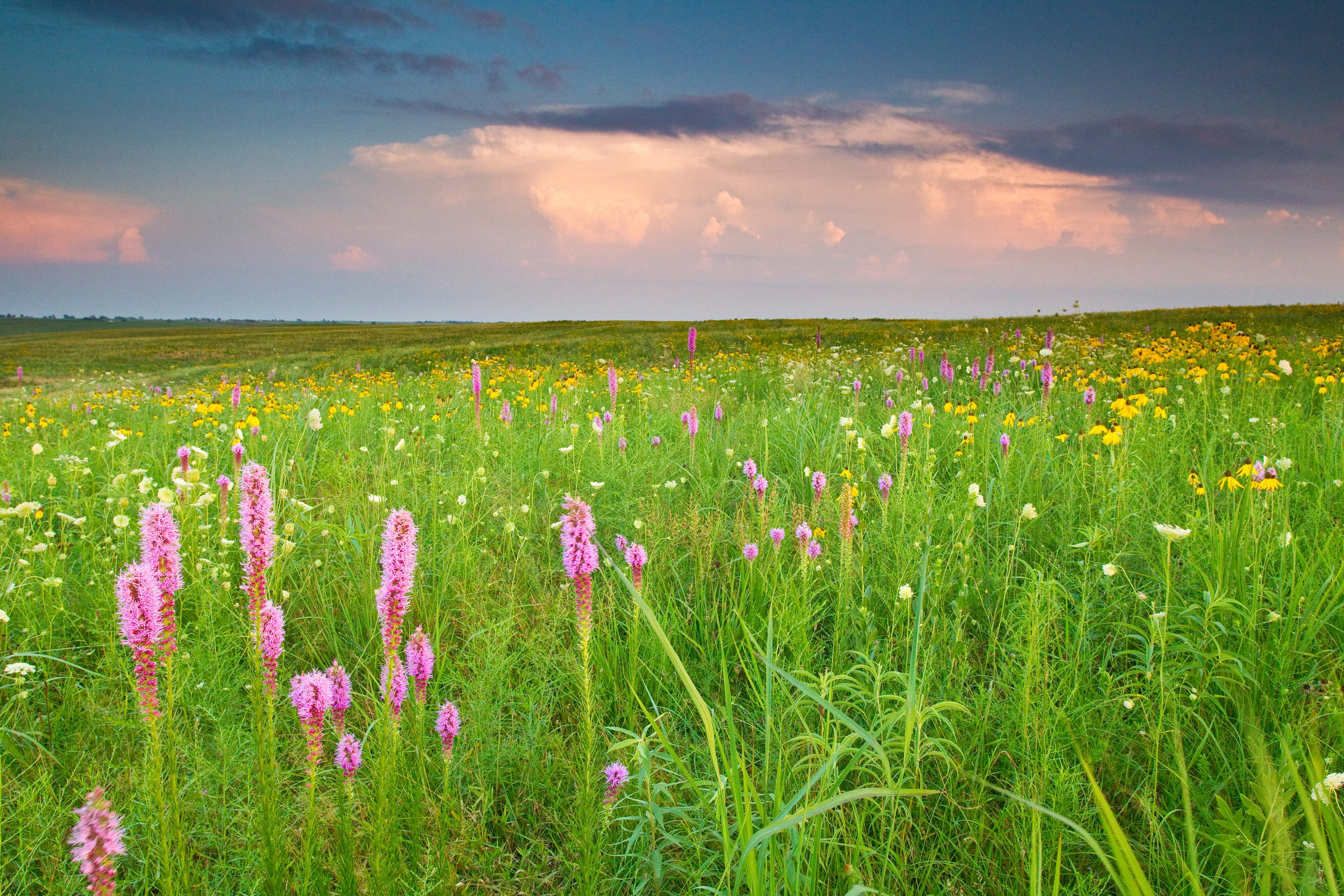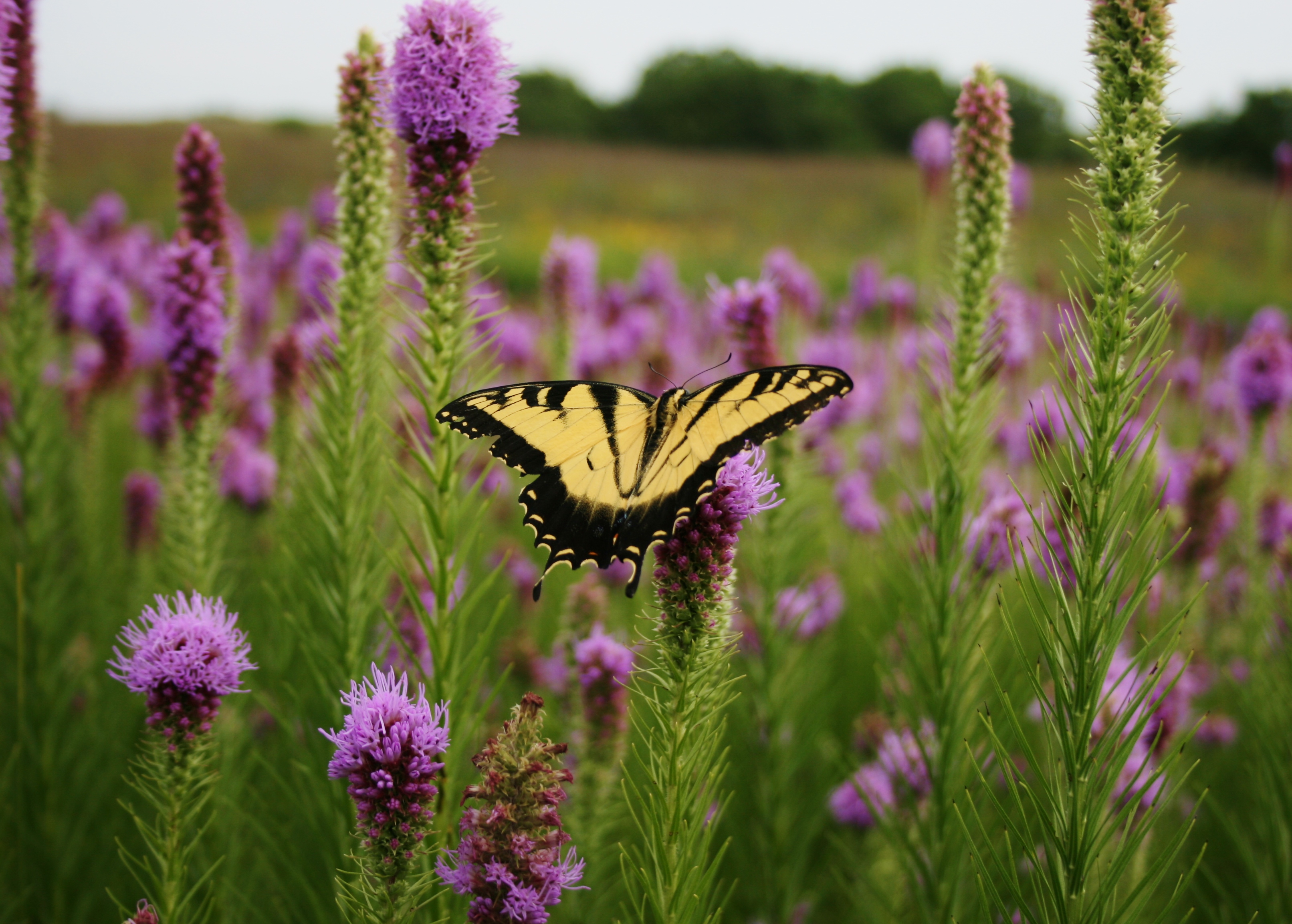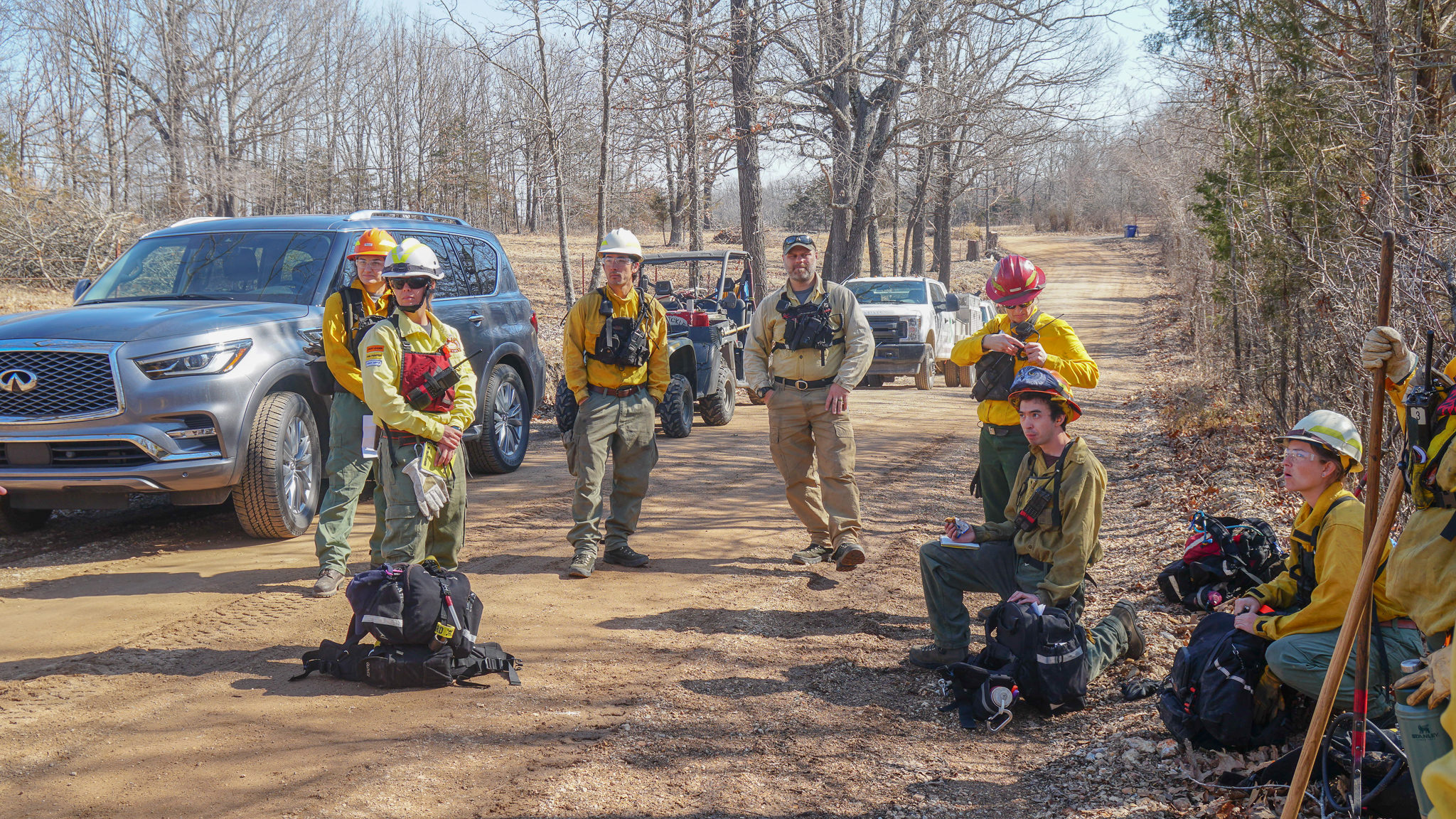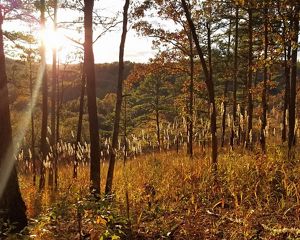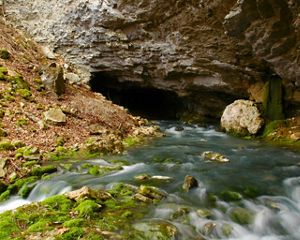
Good Fire Fire and Stewardship Manager Ryan Gauger oversees a prescribed burn at Wah'kon-Tah Prairie. © Kristy Stoyer/TNC
Fire is a natural and necessary part of many ecosystems. More than half of the world’s terrestrial ecosystems rely on fire to maintain their health. In the United States, this is 80% of the lands we aim to conserve.
For more than 60 years, The Nature Conservancy has been at the forefront of using prescribed fire to restore and protect these vital landscapes. Our journey began in 1962 with a small group of college professors and volunteers conducting TNC’s first prescribed fire at the Helen Allison Savanna in Minnesota.
Since then, TNC’s commitment and expertise in fire management has allowed us to work closely with agencies, private landowners and other partners to conduct prescribed burns, engage in collaborative planning and provide hands-on training.
Benefits of Prescribed Fire
By combining scientific insight with traditional practices, prescribed fire, also referred to as a controlled burn, offers a range of ecological benefits, from healthier ecosystems to richer biodiversity.
In Missouri, that legacy continues with a strong focus on education and leadership development. Through training initiatives like the Southern Missouri Prescribed Fire Training Exchange (SOMO TREX) and the Fire Science Workshop, and our work with the Missouri Prescribed Fire Council and Prescribed Fire Associations, we are empowering the next generation of fire practitioners. These programs not only build skills, they build a culture of stewardship.
Prescribed fire is not just a land management technique; it’s a return to ecological balance. Missouri’s landscapes evolved with fire, and many of its native species depend on periodic burns to thrive. Without fire, prairies become choked with woody plants, glades lose their open character and forests grow unnaturally dense, increasing the risk of catastrophic wildfires.
Quote: Ryan Gauger
The majority of our natural areas in Missouri consist of fire-adapted communities. Fires were necessary as part of their natural history, their evolution.
By reintroducing fire in a controlled and thoughtful way, we’re helping nature heal. Each burn is a carefully planned effort that brings together science, safety and community
This work is deeply collaborative. We rely on a growing network of partners, from local fire departments and landowners to students and Indigenous fire practitioners. Together, we are restoring balance to fire-adapted landscapes and ensuring that future generations inherit a healthier, more resilient Missouri.

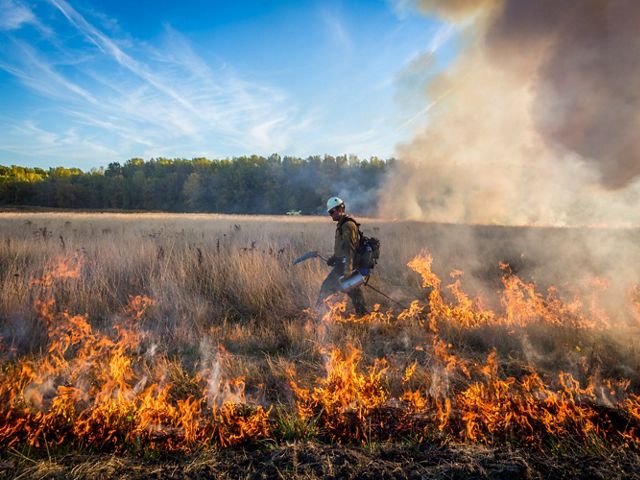
Habitat Strike Teams
To meet the growing need for prescribed fire across Missouri, TNC has developed a strategic model: Habitat Strike Teams. These mobile crews are stationed across the state and deployed where they’re needed most. Each team works in close coordination with partner conservation agencies and are positioned to reduce travel time and increase burn efficiency.
These crews are specially trained to implement land management practices that improve habitat quality for native plants and wildlife. Prescribed fire is one of their most important tools, but their work goes far beyond conducting controlled burns.
Habitat Strike Teams are mobile, skilled and ready to respond to the needs of public and private lands alike. They assist with everything from invasive species removal and brush clearing to firebreak construction and pre/post-burn monitoring. Their presence allows landowners and conservation partners to carry out more frequent and effective management, especially in areas where resources are limited.
These teams play a critical role in expanding Missouri’s capacity for prescribed fire. By providing trained personnel and equipment, they help ensure that burns are conducted safely and successfully. They also serve as a bridge between planning and action, turning ecological goals into on-the-ground results.
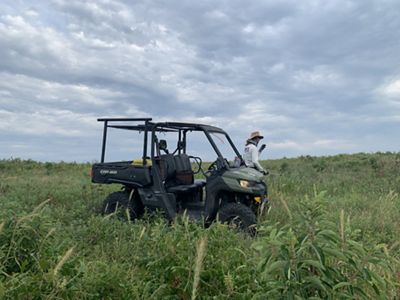
Training the Next Generation of Fire Practitioners
Developing skilled fire practitioners is a cornerstone of TNC in Missouri’s conservation strategy. Through immersive, hands-on programs like the Southern Missouri Prescribed Fire Training Exchange (SOMO TREX) and the Fire Ecology Workshop, TNC is building a skilled, adaptable and collaborative fire workforce.
Southern Missouri TREX
Prescribed Fire Training Exchange, or TREX, is a nationally recognized training program that brings together participants from across the country to gain real-world experience in prescribed fire. Missouri’s diverse landscapes and strong network of conservation partners make it an ideal training ground.
“Missouri is a unique state when it comes to the use of prescribed fire. We aren’t as limited by restrictions and permitting, and there is still a culture of burning in Missouri,” says Gauger. “The Missouri conservation partners have the skills and landscapes to provide lots of training opportunities that allow for wildland firefighters to work on their qualifications.”
One of the keys to this success was flexibility. Instead of operating in large crews, TREX participants were split into smaller squads, allowing them to support multiple burns simultaneously. “We were putting five or six burns on the ground every day,” Gauger says. “Because we were providing that help, agencies could reallocate their own crews to other high-priority burns.”
In spring 2025, the Southern Missouri TREX participants helped implement 26 burn operations across nearly 19,000 acres, despite staffing shortages and challenging weather. “We had a banner year,” Gauger says. “Given how rough the season was, we made the best of it. TREX allowed our partners to get burns done they didn’t think were going to be possible.”
These training efforts don’t just benefit TNC, they strengthen the entire fire community. Participants leave with new skills, certifications and confidence. Agencies gain critical capacity during peak fire seasons. And Missouri’s landscapes benefit from more acres treated with fire.
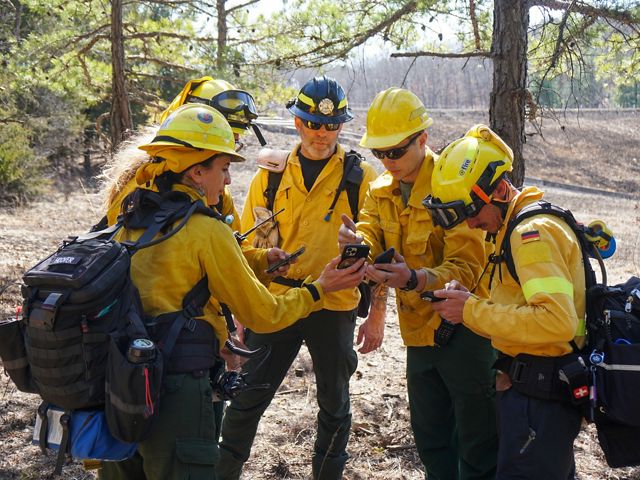

Fire Ecology Workshop
Each year, the Hands On Fire Ecology Workshop brings together land managers, ecologists, students and conservation professionals to explore the ecological principles behind fire-adapted landscapes.
The workshop dives deep into the “why” behind prescribed fire: why certain ecosystems need fire, how fire shapes plant and animal communities, and what happens when fire is removed from the landscape. Participants learn about fire history, ecological succession, species responses and the role of fire in maintaining biodiversity.
What sets the Hands On Fire Ecology Workshop apart is its blend of classroom learning and fire operations blended into one training. Attendees don’t just hear about fire ecology; they see it in action. Guided by experts from TNC and partner organizations, participants visit burn sites, examine post-fire recovery and discuss real-world management challenges. It helps build a shared language between scientists and practitioners, ensuring that fire is used not just safely, but strategically.
In 2025, we hosted our fourth Fire Ecology Workshop in Missouri. We achieved 385 acres of prescribed fire and covered essential classroom topics like fire weather measurement, fuel composition and basic fire behavior dynamics. This successful event marked a true collaboration between fire science and fire operations, bringing together experts from TNC, U.S. Fish and Wildlife Service, the University of Florida and USDA.
By grounding fire management in science, the Hands On Fire Ecology Workshop strengthens Missouri’s conservation community and ensures that every burn contributes to a healthier, more resilient landscape.
Sign up for Nature News.
Sign up to receive monthly conservation news and updates from Missouri.
Prescribed Burn Associations
Prescribed Burn Associations (PBAs) are community-led organizations that work to educate and support anyone interested in the use of prescribed fire as a management tool on privately owned land.
Prescribed Fire Council
The Missouri Prescribed Fire Council, alongside a growing network of Prescribed Burn Associations (PBAs), is at the forefront of a growing movement to restore and maintain the state’s natural landscapes through the use of prescribed fire.
As a statewide coalition of landowners, conservation professionals and fire practitioners, the council works to promote prescribed burning as a safe, science-based land management tool. By providing education, resources and coordination, the council helps ensure that fire is used effectively to improve ecosystem health, reduce invasive species and support biodiversity across Missouri’s predominantly privately owned lands.
“Currently, we have 16 established Prescribed Burn Associations across Missouri,” says Ryan Gauger, TNC’s fire and stewardship manager and chair of the Missouri Prescribed Fire Council, “with another five to seven in various stages of development, which is exciting to see.”
With over 93% of Missouri land being privately owned, these associations play a crucial role in the broader land management strategy. They bring together private landowners, conservationists and fire management professionals to share knowledge, resources and support. By working collaboratively, they ensure that prescribed burns are conducted safely and effectively, maximizing their benefits while minimizing risks.
The Missouri Prescribed Fire Council is working to become a non-profit organization, which will enhance their ability to secure funding and expand their educational programs. “One of our key initiatives is to develop additional trainings for private landowners,” says Gauger. “This includes burn plan development to help landowners create detailed plans for conducting prescribed burns and a “spot fire” workshop to teach PBAs and landowners how to safely manage a fire that escapes their burn perimeter.”
Through these efforts the groups are fostering a culture of responsible land management and empowering individuals to take an active role in preserving Missouri's natural beauty and ecological health.
Fire in Action

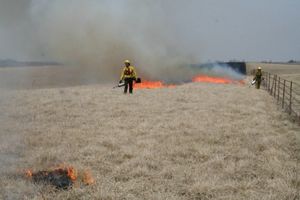



Fire Workshop: Megan Alkazoff, TNC fire and stewardship coordinator at the Bennett Spring partner office, lights the northern border of the Bennett Spring Savanna burn site. © Doyle Murphy/TNC

Controlled burn: TNC staff conduct a controlled burn in the Grand River Grasslands. © J. Wildman

Prescribed burn in Missouri: A member of The Nature Conservancy’s fire team employs a prescribed burn, an important tool used in sustainable forest management. © Tom Fielden

Global Impact: Kylie Paul, a wildlands firefighter in South Africa, plans to take what she learned about controlled burning in Missouri home to promote prescribed fire as a conservation tool © Kristy Stoyer/TNC
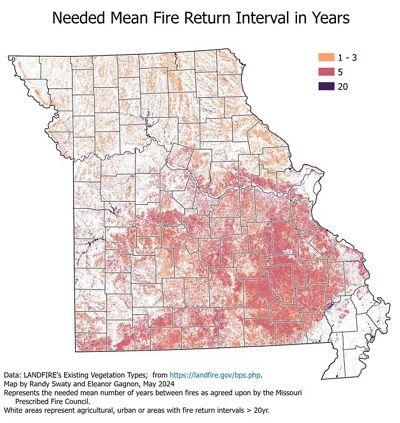
Assessing Missouri’s Fire Needs
In the fall of 2024, Missouri conservationists and ecologists completed a comprehensive Statewide Fire Needs Assessment, revealing critical insights into fire management across the state.
The assessment helps determine how much prescribed burning should be done in Missouri, and where. It found that burning a minimum of 2.6 million acres per year is necessary to replicate the historical occurrences of fire that much of Missouri’s landscape is adapted to. However, current reports from conservation professionals and private landowners estimate only 125,000-150,000 acres are burned each year.
Key findings emphasize the need for more training and resources for prescribed burns, better communication among stakeholders and stronger support for fire management initiatives. Understanding these needs will help Missouri implement strategies to reduce wildfire risks and improve ecological health.
This effort highlights the importance of prescribed fire in maintaining resilient landscapes and communities.
